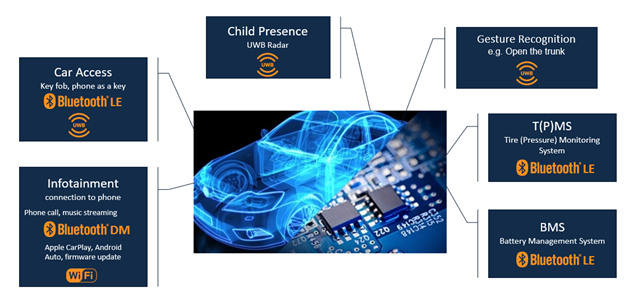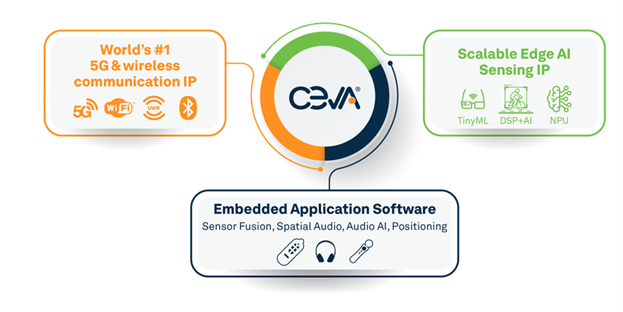When contemplating all the automotive electronic goodies we can add it can be easy to forget that each new feature contributes to cost not only for the feature itself but also in communication between the feature and the larger system, demanding both transceivers and wiring to the central unit. Managing communication overhead has provided a major impetus for the switch to zonal architectures. A zonal structure can reduce the weight of wiring in a car from as much as 5km of wiring (at 100-120 pounds) down to 3km or less, which in turn reduces material cost and power consumption, while increasing range, all very desirable goals for automakers. Which prompts an obvious question – why not reduce cost and weight further through wireless connectivity, especially Bluetooth LE and UWB?

Bluetooth and UWB are the Obvious Starting Points
We already use Bluetooth (increasingly Bluetooth LE) to connect our phones to automotive audio system for music streaming and for phone calls. This technology has been refined in billions of devices across the dominant mobile OSes. Transceivers are compact and ultra-low power, and the standard continues to be enriched as the Bluetooth SIG addresses new and emerging use cases.
Connecting our phones for audio applications is one proof point but now we also see Bluetooth and UWB becoming prominent in automotive keyless entry. The Bluetooth SIG and the FiRa consortium (responsible for UWB) are now working closely to leverage complementary strengths in each protocol, Bluetooth LE for long to medium range raw proximity detection and UWB for centimeter-level accuracy and further security. This combination not only manages range versus accuracy tradeoffs; it also minimizes power consumption by using Bluetooth Low Energy (LE) through most of the range while only turning on UWB for short periods when close to the car. The lifetime of the battery in your key fob is proof enough that this combination is very power efficient.
Next Up, Tire Pressure Monitoring
Tire pressure monitoring systems may not be a glamorous automotive application, but they have become essential to our peace of mind. Now we get enough warning about a puncture to get to a repair station before the tire runs flat, avoiding major inconvenience and possible damage to the wheel hub. We can even be notified that we’re running on a tire over-pressure (prone to a blowout) or under-pressure (reducing fuel efficiency).
Such systems currently work though pressure sensors connected to proprietary systems, installed either in the wheel hub or the tire valve, communicating through a proprietary wireless protocol to a TPMS (Tire Pressure Monitoring System) controller in the car body, which then must connect through a standard wired protocol to the car system. This architecture carries the usual disadvantages in proprietary systems: lack of full interoperability between automotive systems and tire makers, and lack of feature and price competition.

Already onsemi, Dialog/Renesas and more automotive semiconductor suppliers have recognized the opportunity for standardization and have built TPMS reference designs based on Bluetooth LE, offering an ultimate promise of complete interoperability and less wiring if a central Bluetooth LE host can serve these and other Bluetooth LE needs around the car.
UWB for Child Presence Detection, Gesture Detection
Child presence detection (did you leave a child in the car?) is now a mandatory automotive requirement in Europe (Euro NCAP) and is under study in the US NHTSA, especially to minimize heat-related deaths. Detection can be accomplished through UWB radar which sense and detect breath rate. The centimeter-level accuracy of UWB can locate the source very precisely, to not only sense a child in the back seat when leaving the car, but also to sense a child in the front seat, indicating that the passenger airbag should be disabled.

UWB can also be used for gesture recognition, to detect a kick under the rear bumper to open the trunk/trunk door when your hands are full, or for gesture-based control within the cabin (raise your hand to raise volume for example).
In both cases, a Bluetooth LE and UWB combination would offer these benefits of UWB together with longer range (within the car) Bluetooth LE communication to a central Bluetooth LE hub.
Looking further out
EVs are driven by battery packs containing hundreds of batteries. Each must be monitored carefully through battery management systems (BMS) during charging cycles and discharging, demanding a significant level of control and status communication. Today this communication is all wired. You could imagine all the control/status communication per battery could be handled over Bluetooth LE, saving a significant amount of wiring. While still an idea in discussion, the technology is already in place to make this a reality.
Accomplishing this goal could use a Bluetooth LE v5.4 capability, Periodic Advertising with Response, a mechanism already in use in retail applications to update electronic shelf labels (ESL) with updated pricing, special offers, and so on.
More generally, features distributed around the car such as ambient lighting, or microphones around the car supporting adaptive noise cancellation can all benefit from wireless control/feedback. In each case providing an enhanced user experience without the need for yet more wires other than a power supply.
Ceva – for In-Car Communication Without Wires!
Ceva is your one-stop shop for wireless communication, from Bluetooth, to UWB, to Wi-Fi to 5G. We track and certify against these standards, providing in each case embeddable hardware, a full software stack and profiles where appropriate, all backward compatible with earlier versions of each standard.
In addition to protocol certification, Ceva software is certified to MISRA-C and CERT-C and analog/RF components supplied by partners are qualified to AEC-Q100 Grade 1. Our multiple design wins with major automotive SoC suppliers are proof of our standing in this domain.

Our solutions are deployed across a wide range of industries including automotive with multiple customers whose names we can share, and others we cannot share who you otherwise might find even more familiar.
Please check out our website and contact us to discuss your plans to help future cars gain wireless functionality and lose weight!


